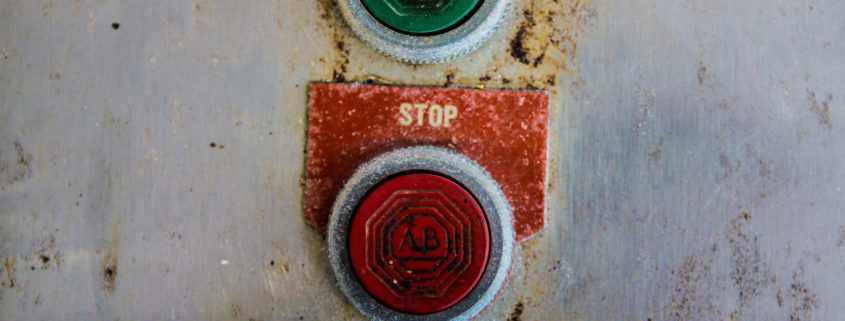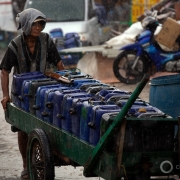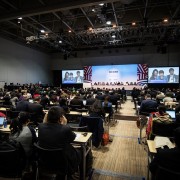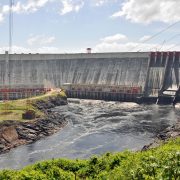The Water ‘Accessibility Trap’: Q&A with Alexandra Campbell-Ferrari and Luke Wilson
Authors of a report on local drinking water laws discuss the lack of water shutoff data and the fees that make it harder for struggling households to stay afloat.

By Brett Walton, Circle of Blue
The first step for effective public policy is good data. And for drinking water access, good data is not readily available, according to a wide-ranging report on water access laws in Maryland. The report from the Center for Water Security and Cooperation, a nonprofit legal research group, is the first to catalogue in a single state the local drinking water laws and policies that affect low-income households and those who have missed a monthly payment.
Circle of Blue’s Brett Walton spoke with Alexandra Campbell-Ferrari and Luke Wilson, the center’s co-founders and report authors, about water shutoffs, late fees, and how the two can combine to create an “accessibility trap.” The following Q&A has been edited for clarity and length.
Why is such a deep look at local laws in a single state important to do?
Alexandra Campbell-Ferrari: One of the reasons that we looked at one state was because honestly no one has done it. And I think you could go either of two ways. You could obviously have just looked at a few laws throughout the country or you could have really looked at one state. One of the things that we were really frustrated with is that other people who had published reports had looked at the state level and looked at state level laws. But everyone knows that the laws that govern these service providers are at the local level, so if it’s the county or the municipality that is providing the services, then that is where you find the law. And we wanted to get a sense of what the disparity is across the state.
So in essence, if you have one state and you look at the local level, then our question was, well, how differently do they take on their responsibilities and how much does it matter? And if you live in one zip code versus another, what does that mean for you? Is there really a difference? Does that devolution of that authority to the local level mean anything? And essentially what we found is that it is incredibly meaningful, that those municipalities do exercise their power in very different ways. And it means that there can be significant disparities between two neighboring municipalities and I think that’s a powerful statement. We don’t make a judgment call about that because we’re trying to get a sense as to what the challenges are and we’re trying to initiate a conversation about it. If there’s this disparity that is generated across the state, is that what we want? Is that our public policy for the state? Is this the result that we’re looking for and if not, what would we do instead?
For people who are already in a financial hole, for whatever reason, a missed bill, particularly with all these other fees, can put water service out of reach and make it, if not permanently inaccessible, then at least deeply inaccessible for a long period of time.”
Luke Wilson: A lot of these laws are promulgated at the local level because service delivery is at the local level. There’s a lot of deference by state authorities in this area. I think after seeing what happened in Flint, as an example, and in other water systems around the U.S., we wanted to get a sense as to what this meant for the law, at the local level, what kinds of powers are included at the local level that balance out the service provision.
How much deference is there, being measured in the range of policies that are out there for late fees and low income rate assistance and ability to decide when residents get shut off?
Campbell-Ferrari: Every municipality and every county can choose their own path so they can all determine whether the water will be shut off for nonpayment. They can determine whether they charge a late fee or reconnection fee or disconnection fee, and interest for nonpayment or late payment. And then they can choose what those fees are. They can choose whether those nonpayments become liens and whether you can foreclose upon them. I mean they have full authority to exercise that right. They have the power to do that.
Wilson: Part of what we’re trying to accomplish with this report was to create both a local-level discussion among the customer and the utility as well as, at least in part, a state-level discussion about whether this kind of deference is ensuring that there is access to these services. Or is there a way that the state could be involved either by providing funding or by providing assistance that would allow this accessibility trap to be avoided by so many of these vulnerable citizens? So that’s a big part of this report: creating that evidence base that can now be used to have a real discussion at both the state level and at the local level.
And you all are not making any recommendations about what that should be, but just wanted to put the information out there?
Campbell-Ferrari: Yes. And we had a lot of conversation about that. This report is the first of its kind. And I think before anybody makes any kind of recommendation, we need to know what we’re working with. The policy recommendations that we make and anybody makes should be responsive to the actual challenges that are being met. And what may be even more frustrating, I honestly joked about this in my water law class, is that every state has its own authority to do what it wants. And so what we find in Maryland may or may not be what we find in other states, which makes this conversation even more challenging and makes it even more, I would say, scary that we really don’t know.
I mean, one of the biggest concerns that we had coming out of this was that no one has ever bothered to ask the questions of why and how is the water being shut off? Why is that the case? Who does it? How do they have that authority and why do they have that authority and what does that mean for their state?
Wilson: I’ll also say that one of the reasons why we didn’t set out specific prescriptions or specific policy moves or legal changes — besides suggesting that if you’re going to have this broad shutoff power that there should be a corresponding low-income rate assistance program to avoid pushing vulnerable citizens into to the accessibility trap — is that we also noticed there isn’t a lot of publicly available data on shutoffs. How many of those people are repeat shut offs? Or whether there’s any clear data on the question of being unable to pay versus unwilling to pay. A lot of this data is held by municipalities someplace. It should be accessible, but I think it would take a lot of time for them to collect that.
And I think that’s another area where the state level can get involved either by providing technical assistance or funding to collect this information. And we didn’t want to make that determination except to say that there should be this balance between shutoff and low-income rate assistance until we knew exactly how the shutoff power was being used. And that data is very hard to find.
Campbell-Ferrari: We can’t find it. In no Maryland municipality or county could we find that data online. In not a single one was that data published.
If there’s this disparity that is generated across the state, is that what we want? Is that our public policy for the state?”
Also, if they’re collecting fees, what are those fees being used for? The other aspect of this that we looked at is the idea of ring fencing. There’s no guarantee based on the law that the money that rate payers are paying for these services is actually being reinvested into the water infrastructure. At the same time, we’re hearing about the water shutoffs, we’re hearing about the fact that our water and sewage infrastructure is crumbling around us, and that it can’t efficiently or safely and reliably provide these services. Yet at the same time we’re looking at laws that say, ‘You get this money from rate payers but it goes into the general fund and it isn’t ringfenced for water infrastructure.’ So what does that do not only for the reliability and the safety of the water infrastructure but for the low-income families who don’t have access to a customer program or low-income rate assistance program?
Wilson: And how does that drive the decision to have higher shutoff fees to make sure that if you are charging these fees, are you doing it as part of a revenue stream or not? That was one of the questions that we posed to a lot of municipalities that we didn’t really get any response on is: where does this money go? You know, when you charge $250 for a shutoff, is that just the money that goes to pay the engineers? Is that money you get to keep? Where is that money? So we don’t even know whether shutoffs are actually a source of revenue, which could also be a significant question.
Just a point of clarification on that: you asked municipalities and utilities about where the money they collected in fees from shutoffs was going and got no response from any of them?
Campbell-Ferrari: We issued the draft report in December of 2017, and the reason that we issued a draft was in large part that we invited all the municipalities and the counties to read it and make sure that the information being portrayed was correct. And we asked them to complete a survey. Out of the 157 municipalities we got 13 responses from people.
Wilson: This wasn’t for a lack of effort. We sent the surveys, we followed up in some cases in person with people, but also over the phone. We had one of our researchers calling sometimes asking these questions, trying to get information. And it wasn’t information that was easily obtainable. But either way, this should be information the system has at its fingertips because they need to know if they are turning off someone’s water and making water inaccessible they need to know why. They need to know how often they’re doing it. That needs to be part of the overall discussion of rates and revenue and the sustainability of their system. But we made that effort and we invited and we talked to people, we tried to get this information in every way that we could and we just couldn’t. As much as we tried we couldn’t.
Campbell-Ferrari: And I will say in large part, we hope that this report will inspire people to respond. And we’re determining whether or not we will reissue that survey and how we want to reengage. But for us that data is really important. And that data will also drive some of the policy recommendations that we could propose.
One of the aspects of the report that I think is most interesting and will be highlighting are the fees and the range of fees that are assessed when water is shut off. Do you have any thoughts on the contradictory nature of the response to shutoffs, which is to add on fees that exacerbate the problem?
In essence, what we’re now seeing are the unintended consequences of what I would say is a well-meaning tool.”
Campbell-Ferrari: It’s interesting. My guess would be that water shutoffs as a tool were created to shut off services to people who just didn’t pay. And you know, this is a service, it’s a service like cable, it’s a service like energy and power and heating and all these other services. Now, it’s a special service because every single one of us needs water and we need it every day in order to survive. There are numbers of people that do not have running water in their homes, but it is less of an issue than in many other countries. But we are taking that for granted. One way we have taken that for granted is by not recognizing that some of the people we are executing shutoffs against just don’t have the money to pay for their water, despite wanting to, despite recognizing the value that it has they just don’t have that money. So I think the basic tool itself was created to generate accountability. And I just don’t think that we’ve ever gone back and really thought about what that meant. It’s kind of like the unintended consequence. In essence, what we’re now seeing are the unintended consequences of what I would say is a well-meaning tool. Utilities can’t just provide these services without their customers paying. What this report tries to do is to lay bare those unintended consequences so that we can decide what that means and if that’s what we want moving forward.
Wilson: When someone can’t pay their bill, it becomes a bit of a rolling stone gathering moss. And maybe that’s the wrong way to use that image. But the problem becomes deeply compounded as these fees get added on. For people who are already in a financial hole, for whatever reason, a missed bill, particularly with all these other fees, can put water service out of reach and make it, if not permanently inaccessible, then at least deeply inaccessible for a long period of time. So then one of the things we don’t know yet, and again there are a lot of thing we don’t know, is what happens at that point? Where do people turn for water? Water is not necessarily fungible so how do people replace that shutoff water? Do they go to supermarkets and spend money for water that they should be spending on food? How do they replace the ability to shower in their own home? These are things that we don’t know: how behavior is reacting to the shutoffs. Partially because we don’t really know the extent of the problem. But it’s also because there’s a lot of other pieces that are tied into it. But that’s a significant issue. If the fees are making water more unattainable, then there are going to be other hits to other areas of social welfare that are going to be impacted as well. And we don’t have a sense of that.
You titled the report the ‘accessibility trap.’ So how do you each define accessibility trap?
So that inaccessibility of water, to her, meant that she ended up losing her job because she couldn’t engage in the basic hygiene that was expected of her.”
Campbell-Ferrari: We started out with talking about the tension — the tension between this idea that water is something so essential for existence, but by the same token, infrastructure service providers need money to do it. Yet there are people who just fundamentally can’t pay. And so we started out with that. And what happened is, as we looked at it, honestly it was actually the fees that kind of brought this to our attention.
Your question really gets to the heart of it, which is that there’s this irony to it: essentially you don’t have enough money to pay your bill so now you’re late on your payment. And now an additional fee can be charged. And then eventually if you don’t pay the original bill plus the fees then your water is shut off and then once your water is shut off, then additional fees are charged. And this is in the same period in which you’re trying to get the money to pay the original bill. So now you have, God only knows how many layers of fees that have been attached to it. And then if you ultimately don’t pay back the fees, if you don’t pay back the original charge in some instances, if you don’t show up in person in the municipality, then you can never have your water returned to you. So sometimes you have to be there in person or you have to pay two additional months in advanced on top of the fee, on top of your original bill.
I mean, there’s all these kinds of idiosyncratic additional hoops that you have to jump through. And ultimately you, you may not ever get out of this trap. You may not ever be able to pay enough money back to get access to water again. And especially if the utility doesn’t offer rate assistance programs. And one of the things is also part of it is that, you know, we look at payment plans, payment plans are kind of, they’re a Band-Aid, you know, alternately on, under a payment plan, you still have to pay that original bill, the fees that you have. And so you’re still fighting to get that money to pay those bills and he could wind up in the same very position where you would have your water shut off. So this cycle of the fees, and the shutoffs, and the extra fees, and the fact that that can be turned into a lien and then foreclosure can happen on that lien. I mean it, it represents a trap that you could potentially never ever get out of.
Wilson: I think it even goes broader than that. I was talking about that a little bit with the notion of food stamps and finding a way to pay for water once it’s turned off, at least for consumption. We don’t know how the accessibility trap for water is also impacting broader societal poverty and the impacts of poverty. I was reading an article in the Washington Post the other day — I don’t know if you’ve had a chance to see it. It was about a woman who was living on the street and cataloging how she got there. Part of it was, where she had been living was declared uninhabitable by the Fire Department, and she had to leave as a result of that. But she had a solid job at the time and because she had nowhere to live and couldn’t get another place fast enough, she didn’t have a place to bathe and there were complaints about her at work. So that inaccessibility of water, to her, meant that she ended up losing her job because she couldn’t engage in the basic hygiene that was expected of her. And that forced her even deeper into poverty, to the point now where now she’s living in a tent on the street in southeast Washington. Because we can’t see how many shutoffs are occurring and we can’t really get a sense of what the impacts are down the road, we have to use those anecdotal points to say there’s a trap here in terms of inaccessibility. But it’s also part of a broader societal inequality that pushes people even deeper into poverty because they don’t have access to hygiene or because they have to spend money on bottled water that they would spend on food. So there are a lot of dominoes that fall once you start looking at it.
Brett writes about agriculture, energy, infrastructure, and the politics and economics of water in the United States. He also writes the Federal Water Tap, Circle of Blue’s weekly digest of U.S. government water news. He is the winner of two Society of Environmental Journalists reporting awards, one of the top honors in American environmental journalism: first place for explanatory reporting for a series on septic system pollution in the United States(2016) and third place for beat reporting in a small market (2014). He received the Sierra Club’s Distinguished Service Award in 2018. Brett lives in Seattle, where he hikes the mountains and bakes pies. Contact Brett Walton











Good time to startup this discussion again. And 3 cheers for Center for Water Security and Cooperation. Flint and Detroit (Baltimore, too) residents are still suffering and denied access or safe water, forced to buy bottled water that is more expensive than the city water they can’t afford, so are financially strapped small, rural communities. The fact is several states subject local water utilities to oversight and regulation by state public utility or public service commissions. Some have the authority to do so, but don’t exercise it. For example, Michigan’s Public Service Commission has authority to oversee and regulate water as a public utility and service, but in the nearly 100 years since the laws passage, the commission has done nothing to implement that authority; rather, as your article points out, too often this is left to local governments. But this isn’t necessarily the primary problem on water access, and the right to clean, safe water. The core problem is that water utilities are not viewed more as physical systems that deliver water on a shared-cost basis, without understanding the true nature of the service: when people occupying homes are required to connect to a public water supply system, they are no longer allowed to tap their own groundwater. In other words, it is a substitute system for their right to use groundwater. This right to use groundwater guarantees the occupant or landowner the right to drinking water, water for bathing and sanitation, and the right to grow food and provide other basic needs. If the public system is a substitute, then the right use the water by each landowner for these basic needs and uses should be assured by the public substitute system. If this is done, then all will be assured at minimum cost access to clean, safe water as a right for the first 7000 gallons or so (as determined by these basic daily needs); those who use or want more water than that, for commercial, industrial or other large quantity uses should pay more, not the same, and certainly no less, as if water was a Wal-Mart-discount item: it’s a public monopoly, there’s no need for discounts. Santa Fe has done this, other communities are doing it as well. And, it works. The higher water users end up conserving, so don’t pay more, and more water is available and less wasted that reduces overall costs. In addition, we need a “bill of rights” for public water, public water supply systems, that assure access, health, accountability, transparency, overall justice and dignity of each person. For those interested, see e.g., FLOW’s Model “Public Water, Public Justice Act” — a proposal for Michigan and other Great Lakes states. http://www.flowforwater.org.